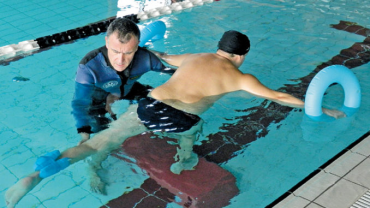Hydrokinesis

The aquatic environment for the patient represents a barrier-free liquid space in which to have new motor experiences in an environment in which the influence of gravity can be modulated; a protected environment in which the patient can move freely without the fear of falling or in which to re-experience or experiment with, all dimensions of space.
It also creates motivation and interest as well as physical pleasure in the patient, and therefore represents a good
therapeutic choice, especially, in those individuals who need to live and internalize a motor experience in its entirety.
Evolution of the A.S.P. Method (Propedeutic Sequential Approach) Finalized Logical Sequences (S.L.F.)
Hydrokinesiotherapy takes advantage of the physical properties of water and allows the practitioner to assess the patient's residual abilities and set up, in a favorable and stimulating setting, therapeutic training to best develop his or her residual potential.
The resistance that water offers to submerged bodies slows down the execution of a movement, and this facilitates the learning of a motor gesture, which is broken down and analyzed phase by phase, and its re-insertion within a motor pattern that was perhaps lost or never learned.
Water responds to well-established physical laws, and for this reason hydrokinesiotherapy can only assume of the use of the physical principles of water.
There are three main physical properties that are exploited in hydrokinesiotherapy: Buoyancy, Forward Resistance, and Hydrostatic Water Pressure.
The evolution of the A.S.P. Method refers to the manner in which the proposed exercises are chosen, which involve an increasing load of difficulty, a "sequentiality" based on whether or not the previous exercise is learned, and a "timing" of temporary succession of exercises that takes into account the therapeutic goals and assessments carried out in the dry environment.
The term Propaedeutic indicates the choice of Logical Sequences in water aimed at the execution and/or learning of motor skills
Functional to the patient's autonomy and quality of life.
Each treatment begins with an assessment, which is preceded by an initial evaluation in the dry environment necessary to analyze the patient's residual abilities and the possibility of including or not including some specific sequences of work directly in the water.
In the in-water assessment, it is essential to analyze the patient's hydrostatic buoyancy in the three working planes (supine,seated, and prone) and postural transitions, better defined as buoyancy changes.
The assessment is essential to set up a treatment built on the patient's abilities and aimed at recovering his or her autonomy, taking full advantage of the physical properties of water and not trying to reproduce in a microgravity environment what happens on dry land.
This type of approach allows us to work globally on muscle recruitment through alternating eccentric and concentric contractions, on body schema and balance through water destabilizations, and on proprioception through hydrostatic buoyancy.
Translated with www.DeepL.com/Translator (free version)
